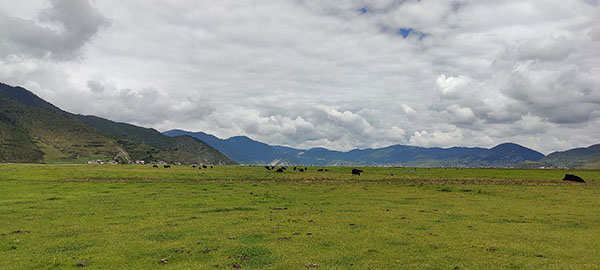中国科学院大气物理研究所大气科学和地球流体力学数值模拟国家重点实验室
State Key Laboratory of Numerical Modeling for Atmospheric Sciences and
Geophysical Fluid Dynamics (LASG)
Institute of Atmospheric Physics, Chinese Academy of Sciences
State Key Laboratory of Numerical Modeling for Atmospheric Sciences and
Geophysical Fluid Dynamics (LASG)
Institute of Atmospheric Physics, Chinese Academy of Sciences

Vol.19/No.19 December 2023
JC: Deciphering the Influence of Asia's Elevated Terrain on Spring Cloud Cover and Radiation Budget

Tibetan Plateau and clouds. (Image by LI Jiandong)
Picture this: in South China, springtime brings a peculiar phenomenon. Thick clouds linger, making the sun a rare sight. Strangely, these clouds pack a powerful cooling punch, taking away as much energy as a lightbulb emits. This cooling effect shapes our region's temperature patterns and even our local weather. But why does this happen, and what's the connection with the distant Tibetan Plateau?
Interestingly, ancient Chinese scholars like Liu Zongyuan noticed this centuries ago, describing cloudy days with the curious phrase "dogs bark at the sun" because sunlight is such a rarity. These observations link with a mysterious weather puzzle we've struggled to solve.
In response to these puzzles, researchers from the Institute of Atmospheric Physics at the Chinese Academy of Sciences (IAP/CAS), First Institute of Oceanography at the Ministry of Natural Resources of China, the University of Birmingham, and the University of Exeter, have employed satellite retrievals, reanalysis data, and the latest CMIP6 GMMIP terrain experiments to explore the influence of the Tibetan Plateau on spring cloud cover and atmospheric radiation budget over East Asia.
They've unmasked that the Tibetan Plateau shapes the contemporary geographical distribution of spring East Asian cloud amount and atmospheric radiation budget to a large extent. By orchestrating airflows and radiation energy transfers, the plateau's formidable silhouette choreographs a pivotal role in dictating our skies and temperatures.
Think of the Tibetan Plateau as a giant puzzle piece. Imagine removing that puzzle piece, and you'd notice a dramatic change. "Numerical experiments have unveiled that in the absence of the plateau's topography, cloud cover and cloud radiation cooling effects during spring over eastern and southern China decrease substantially." Explained the lead author, Dr. LI Jiandong from IAP/CAS. This experiment highlights just how much the plateau influences our climate system. When you add the plateau back into the equation, its shape enhances airflows that carry moisture, generating more clouds over South China.
But it's not just about clouds. The plateau's shape also heats the air, creating areas of low pressure over the huge plateau. “The plateau's thermal influence prompts surface warming and lower-level cyclones, while its heat pump effect draws air upwards on the eastern plateau side. This induces upward motion and water vapor convergence over southeastern China.” Said Dr. Ruth Geen from the University of Birmingham.
This new study, published in Journal of Climate, bridges a gap in our understanding of how the Tibetan Plateau can impact its downstream weather and climate. By connecting the dots between the plateau's shape, cloud cover, and radiation budget, we're gaining insights that could help us better predict and understand our own regional climate.
Reference:
Li., J. D., R. Geen, J. Y. Mao, Y. J. Song, G. K. Vallis, and G. X. Wu, 2023: Mechanical and thermal forcings of Asian large-scale orography on spring cloud amount and atmospheric radiation budget over East Asia. Journal of Climate, 36(15), https://doi.org/10.1175/JCLI-D-22-0797.1.
Link:https://journals.ametsoc.org/view/journals/clim/36/15/JCLI-D-22-0797.1.xml
Conact:LI Jiandong, lijd@mail.iap.ac.cn
Add: No.40, Huayanli, Beichen West Road, Chaoyang District, Beijing P.O. Box 9804, 100029, China
E-mail: lasg_newsletter@lasg.iap.ac.cn
Editors: Chuanyi Wang (wangcy@lasg.iap.ac.cn), Kangjun Chen(ckj@lasg.iap.ac.cn)
E-mail: lasg_newsletter@lasg.iap.ac.cn
Editors: Chuanyi Wang (wangcy@lasg.iap.ac.cn), Kangjun Chen(ckj@lasg.iap.ac.cn)